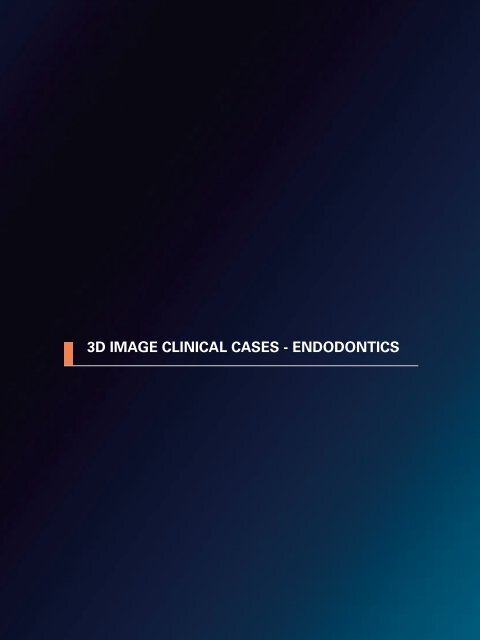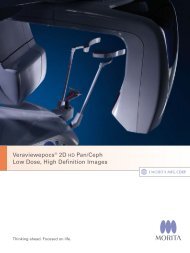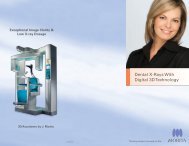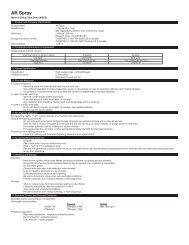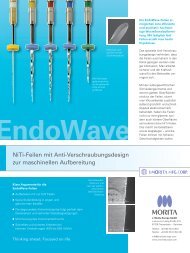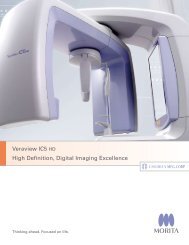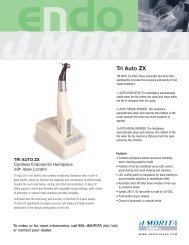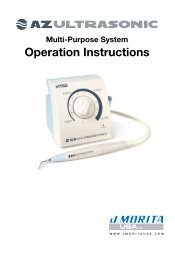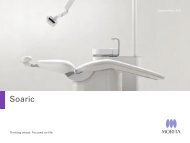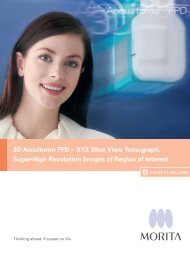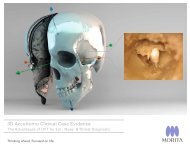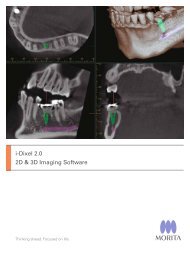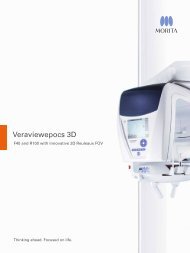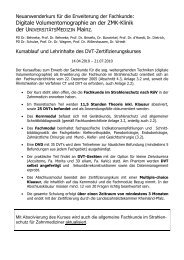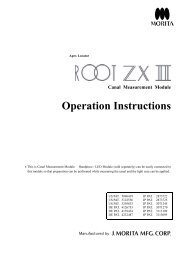3D IMAGE CLINICAL CASES - ENDODONTICS - morita
3D IMAGE CLINICAL CASES - ENDODONTICS - morita
3D IMAGE CLINICAL CASES - ENDODONTICS - morita
You also want an ePaper? Increase the reach of your titles
YUMPU automatically turns print PDFs into web optimized ePapers that Google loves.
<strong>3D</strong> <strong>IMAGE</strong> <strong>CLINICAL</strong> <strong>CASES</strong> - <strong>ENDODONTICS</strong>
2<br />
CONTENTS<br />
n <strong>ENDODONTICS</strong>........................................................................ 3<br />
n TOOTH FRACTURE............................................................... 15<br />
n LATERAL LUxATION............................................................ 18<br />
n INTERNAL RESORPTION.................................................... 19<br />
n ENAMEL DROP..................................................................... 23<br />
Supervised by Yoshinori Arai,DDS, PhD<br />
Professor Nihon University<br />
School of Dentistry<br />
Clinical images are provided by:<br />
(Listed in alphabetical order)<br />
L. Stephen Buchanan, DDS, FICD, FACD<br />
Alan H. Gluskin, DDS, Professor and Chair<br />
Department of Endodontics<br />
University of the Pacific<br />
Arthur A. Dugoni School of Dentistry<br />
Hans-Goran Grondahl, DDS, PhD (Odont Dr)<br />
Professor emeritus<br />
Department of Oral and Maxillofacial Radiology<br />
Institute of Odontology<br />
The Sahlgrenska Academy<br />
Gothenburg University, Gothenburg, Sweden<br />
Dr. Richard S. Kahan<br />
Director of Endodontic Courses<br />
Honorary Clinical Lecturer<br />
Eastman CPD<br />
University College London (UCL)<br />
Marcel Noujeim, DDS, MS<br />
Oral and Maxillofacial Radiology<br />
University of Texas Health Science Center at San Antonio<br />
Erkki Tammisalo<br />
Emeritus professor of Oral Radiology<br />
Tomodent, Private Laboratory of Oral Diagnostic Imaging<br />
Turku, Finland<br />
Sotirios Tetradis, DDS, PhD<br />
Professor and Chair<br />
Section of Oral and Maxillofacial Radiology<br />
UCLA School of Dentistry<br />
Mitsuhiro Tsukiboshi, DDS, PhD<br />
Private Practice, Tsukiboshi Dental Clinic, Aichi, Japan<br />
<strong>3D</strong> Accuitomo Veraviewepocs <strong>3D</strong>
(Fig. 5A)<br />
(Fig. 5B)<br />
(Fig. 5D)<br />
<strong>ENDODONTICS</strong> CASE 1<br />
The patient presented below suffered from an<br />
irreversibly inflamed pulp in tooth #2, confirmed<br />
by prolonged thermal responses to cold and heat.<br />
Conventional radiographs revealed a fused root<br />
structure with little or no information about the root<br />
canal anatomy (Fig. 5A).<br />
(Fig. 5C)<br />
Accuitomo imaging revealed that this molar had only three canals (reassuring), and<br />
that the two buccal canals merged in the apical third and bifurcated again (Figs. 5B<br />
& C). The post-operative conventional radiograph shows this anatomy treated out,<br />
with pre-informed anatomic knowledge (no looking for a fourth canal, knowing that<br />
the buccal canal merge apically—very unusual—and with adequate time committed<br />
to the irrigation process that allowed a three-dimensional obturation of the apical<br />
bifurcation of the canal system after the confluence (Fig. 5D).<br />
-The case in this page was provided by Dr. L. Stephen Buchanan<br />
taken with the <strong>3D</strong> Accuitomo.<br />
3
4<br />
(Fig. 6A)<br />
(Fig. 6C)<br />
(Fig. 6E)<br />
<strong>ENDODONTICS</strong> CASE 2<br />
The patient presented with an irreversibly inflamed pulp in tooth # 3, confirmed by<br />
cold and heat testing (prolonged responses). Conventional radiographs revealed<br />
mesio-buccal root anatomy that was very curved, with the disto-buccal and palatal<br />
root anatomy appearing fairly straight (Fig. 6A).<br />
Accuitomo CT imaging revealed a different story, allowing me to tread carefully during<br />
treatment (Figs. 6B.). The first bit of important information was that this tooth<br />
unusually had only three canals (Fig. 6C).<br />
(Fig. B)<br />
(Fig. 6D)<br />
The second piece of very important information was that the curvature of the<br />
mesiobuccal canal was truly awe-inspiring (Fig. 6D). The third piece of information<br />
saved my self respect and the patient’s tooth from a broken rotary file, it<br />
revealed a severe canal curvature—in the normally-hidden buccal plane (Fig. 6E),.<br />
Treatment, as a result was quick and sure with an exceptional (sorry, but it’s true)<br />
result (Fig. 6E).<br />
-The case in this page was provided by Dr. L. Stephen Buchanan<br />
taken with the <strong>3D</strong> Accuitomo.
(Fig. a)<br />
(Fig.e) (Fig.f)<br />
(Fig.g)<br />
<strong>ENDODONTICS</strong> CASE 3<br />
(Fig.c) (Fig.d)<br />
(Fig.i) (Fig.j)<br />
(Fig.h)<br />
(Fig.b)<br />
(Fig.l)<br />
a. b. The first examination. A 20 year old male.<br />
The chief complaint was the discoloration of<br />
the crown of #9 and slight pain. External resorption<br />
from the palatal aspect and LEO were<br />
found. He has an experience of subluxation of<br />
the involved tooth 3 years ago.<br />
c. d. CBCT appearances. c: sagittal. d: axial. The<br />
root resorption start from the cervical area on<br />
the palatal aspect and invaded into the dentin.<br />
e. The extracted #9 for the surgical extrusion.<br />
Note the large lacuna on the palatal aspect.<br />
f. The trimmed #9. 2-3mm of the apex was cut<br />
off and the apical foramen was retro-filled with<br />
light curing GIC. The crown portion was cut off<br />
obliquely.<br />
g. Just after the surgical extrusion. The root<br />
was rotated 180 degree. The fixation was only<br />
with the suture strings. Surgical dressing was<br />
applied for the first two days and the suture<br />
was removed 4 days after the surgery. No other<br />
splinting was performed any longer.<br />
h. 3 weeks after the surgical extrusion and just<br />
after the restoration of the crown with composite<br />
in a direct method.<br />
i. A radiograph two months after the surgery.<br />
j. A radiograph 1 year post op.<br />
k. A clinical appearance I year post op.<br />
(Fig.k)<br />
l. CBCT appearance 1 y. pot op. The<br />
PDL space and the buccal alveolar<br />
bone is nicely preserved. No resorption<br />
is observed. Interesting is that<br />
the PDL is formed over the retrofilling<br />
materials.<br />
-The case in this page was provided by Dr.Tsukiboshi<br />
taken with the <strong>3D</strong> Accuitomo.<br />
5
6<br />
(Fig.a)<br />
<strong>ENDODONTICS</strong> CASE 4<br />
(Fig.c) (Fig.d)<br />
(Fig.e)<br />
(Fig.g)<br />
(Fig.f)<br />
(Fig.h)<br />
a. ~f. Before treatment. A 46 year old female. The chief<br />
complaint is pain around #3.<br />
The bone of the sinus floor is badly resorbed and the<br />
Schneiderian membrane is thickened due to inflammation.<br />
The cause was considered to be the inappropriate canal<br />
treatment of the mesial root.<br />
a: Periapical radiograph<br />
b: Clinical view<br />
c: Coronal view of the mesial root<br />
d: Coronal view of the palatal root<br />
e: Coronal view of the distal root<br />
f: Sagittal view of the mesal and distal roots<br />
(Fig.b)<br />
g. During treatment. Only the mesial root was retreated<br />
endodontically using a microscope.<br />
h. Periapical radiograph six months later.<br />
i ~ l: CBCT appearance six months later. The sinus bone<br />
has come back and the Schneidarian membrane looks<br />
normal.<br />
(Fig.i) (Fig.j) (Fig.k)<br />
(Fig.l)<br />
-The case in this page was provided by Dr.Tsukiboshi<br />
taken with the <strong>3D</strong> Accuitomo.
# 10<br />
# 9<br />
<strong>ENDODONTICS</strong> CASE 5<br />
8 months<br />
8 months<br />
2year.9m<br />
2year.9m<br />
Apicoectomy and follow-up<br />
with CBCT<br />
A 41 year old female. #9 and<br />
#10 suffer LEO and apicoectomy<br />
was indicated.<br />
3mm of each apex was cut off<br />
and the bony defect was filled<br />
with Bio-oss after the retrofillings.<br />
The healing of the<br />
involved teeth was followed<br />
up with CBCT.<br />
-The case in this page was provided by Dr.Tsukiboshi<br />
taken with the <strong>3D</strong> Accuitomo.<br />
7
8<br />
<strong>ENDODONTICS</strong> CASE 6<br />
The periapical and panoramic radiographs show an “acceptable” endodontic<br />
treatment reaching the slightly lateral apex of tooth # 10. The endodontic<br />
filling lateral appears to be “doubled”, giving the impression of the presence<br />
of two canals. Ill-defined periapical radiolucency is noted slightly on the<br />
distal aspect of the apical third.<br />
Cone beam images show that the gutta percha is perforating the facial<br />
aspect of the root and the buccal cortex. Some gutta perch is found in the<br />
canal but it is not reaching the apex.<br />
Periapical radiograph is a 2d presentation of a 3d object; it collapses all the<br />
structures in the examined area in one plane. The image of the gutta percha<br />
is projected over the image of the root giving the impression of an acceptable<br />
treatment.<br />
-The case in this page was provided by Marcel Noujeim DDS MS<br />
taken with the <strong>3D</strong> Accuitomo.
<strong>ENDODONTICS</strong> CASE 7<br />
The periapical radiograph shows a<br />
well corticated, 3-4mm periapical<br />
radiolucency onto the second molar.<br />
The tooth is endodontically treated<br />
and the endodontic filling material is<br />
homogenous, well condensed, and<br />
reaching the apex.<br />
On the cone beam CT, the periapical<br />
lesion presence is confirmed with the<br />
presence of a severe vertical periodontal<br />
bone loss reaching the apex<br />
of the tooth in the form of what we<br />
call “endo-perio’ communication. This<br />
finding was not seen on the periapical<br />
film due to the projection of<br />
the buccal and palatal thick cortical<br />
bones over the image of the periodontal<br />
lesion.<br />
-The case in this page was provided by Marcel Noujeim DDS MS<br />
taken with the <strong>3D</strong> Accuitomo.<br />
9
10<br />
<strong>ENDODONTICS</strong> CASE 8<br />
Palatal side Buccul side<br />
The patient was complaining of diffuse<br />
pain over the left maxilla. Conventional<br />
radiographs did not reveal patholigical<br />
changes in the periapical region of<br />
premolars and molars. A Veraviewepocs<br />
<strong>3D</strong> scan shows an air-filled, healthy,<br />
maxillary sinus and a periapial lesion at<br />
the apex of the buccal root of the first<br />
premolar.<br />
-The case in this page was provided by Dr. Erkki Tammisalo<br />
taken with the Veraviewepocs <strong>3D</strong>.
<strong>ENDODONTICS</strong> CASE 9<br />
An endodontist had taken several<br />
images of the upper right molar region<br />
on a patient who presented with<br />
pain. He could see that a lesion was<br />
present at the first molar, but was<br />
uncertain about its extent.<br />
The Accuitomo images showed a le-<br />
sion with a very large extent in all di-<br />
rections. It has caused a break-down<br />
of both the buccal and palatal cortical<br />
borders. It extends into the lateral<br />
part of the nasal cavity and the lower<br />
part of the maxillary sinus where a<br />
reaction is seen in the mucosa. The lesion<br />
also involves the root system of<br />
the second molar and gets very close<br />
to the unerupted third molar. None of<br />
this could be anticipated from intraoral<br />
radiographs alone.<br />
-The case in this page was provided by Hans-Göran Gröndahl Professor emeritus, DDS, PhD<br />
taken with the <strong>3D</strong> Accuitomo.<br />
11
12<br />
<strong>ENDODONTICS</strong> CASE 10<br />
Although having taken several intraoral radio-<br />
graphs, an endodontist still felt uncertain about<br />
the conditions at the upper right second molar<br />
from which the patient still felt some pain after<br />
an endodontic treatment had been completed.<br />
The Accuitomo images show lesions at the two buccal roots and at a palatal<br />
root, but also that a second palatal root exists in which the root canal has not<br />
been treated. In addition, a lesion is seen in the interradicular area between<br />
the latter and the mesiobuccal root. The lesion at the buccal roots extends into<br />
the lower part of the maxillary sinus in which a thickening of the mucosa can<br />
be seen.<br />
-The case in this page was provided by Hans-Göran Gröndahl Professor emeritus, DDS, PhD<br />
taken with the <strong>3D</strong> Accuitomo.
(Fig. A)<br />
(Fig. D)<br />
<strong>ENDODONTICS</strong> CASE 11<br />
(Fig. B) (Fig. C)<br />
(Fig. E)<br />
Clinical examination of the LR5, LR6 and LR7, revealed no abnormalities with<br />
no tenderness to palpation at the buccal and lingual root apices and no tenderness<br />
to percussion of any of the teeth. Vitality testing could not be carried out<br />
at the LR6 as the crown margin was subgingival. The LR7 predictably did not<br />
respond to the electric pulp test. The periapical radiograph (Fig. A ) revealed<br />
widening at the periapex of the LR7 with no other signs of pathology.<br />
The sagittal slices of the microCT<br />
scan (Fig. B) however clearly showed<br />
a 4mm circular lesion associated with<br />
the apex of the distal root of the LR7.<br />
The reason why this could not be<br />
seen on the periapical radiograph<br />
could be understood from the coronal<br />
slice (Fig. C) that shows the lesion<br />
positioned entirely in cancellous<br />
bone and not involving the cortical<br />
plates – the prerequisite for visibility<br />
on a standard periapical radiograph.<br />
Furthermore the anatomy of the root<br />
canals in the LR7 could be visualized<br />
with there being clearly one mesial<br />
and one distal canal (Fig. D).<br />
Without the microCT scan provided by the Veraviewepocs <strong>3D</strong>, an attempt<br />
would have been made to find another canal in the LR7, as there was no reason<br />
to treat the LR6. Significant damage to the root of the tooth would have occurred<br />
before the search would have been abandoned, and the patient would<br />
still have been in pain following the procedure. With the scan, treatment was<br />
initiated immediately in the LR6 and the pain quickly eased. Endodontic treatment<br />
of the LR7 when completed, was done without further damage in an<br />
attempt to locate a second mesial canal (Fig. E).<br />
-The case in this page was provided by Dr. Richard S. Kahan<br />
taken with the Veraviewepocs <strong>3D</strong>.<br />
13
14<br />
(Fig. J)<br />
<strong>ENDODONTICS</strong> CASE 12<br />
A 24 year old male patient attended 2 years following root canal therapy of his upper<br />
right central and lateral incisors (UR1 and UR2) with a draining buccal fistula<br />
(Fig. J). The teeth had been originally traumatised aged 10 and the apices were<br />
incompletely formed. On presentation with periapical infection aged 22 (Fig. F),<br />
the orthograde root canal treatments that were carried out had initially involved<br />
calcium hydroxide therapy followed by obturation with MTA apical plugs (Figs. G<br />
& H). Initial follow up at 6 months suggested some resolution (Fig. I ), but the appearance<br />
of a fistula 18 months later confirmed regression and re-infection.<br />
(Fig. F) (Fig. G) (Fig. H) (Fig. I)<br />
A microCT scan of the lesion using the Veraviewepocs <strong>3D</strong> (Figs. K & L) revealed the true size<br />
of the lesion with both buccal and palatal plate perforations. The usual treatment of a recurrent<br />
periapical lesion with a satisfactory orthograde root filling would be buccal approaching<br />
periapical surgery with lesion curettage, apicectomy and possibly an apical retrograde<br />
seal. However, if this would have been carried out with such a lesion, soft tissue ingrowth<br />
from the palatal side would resist bony repair. True repair of a lesion of this size would<br />
require either a membrane on one side if the lesion to resist soft tissue ingrowth, or decompression<br />
followed by conventional surgery. Whichever is chosen, neither would have been<br />
immediately considered in a case such as this, and therefore, poor bone healing would have<br />
followed on from a standard surgical approach without the benefit of the microCT scan.<br />
(Fig. M) (Fig. N) (Fig. O)<br />
In this case a decompression procedure was carried out and a plastic drain was placed<br />
buccally (Fig. M & N) with the patient instructed to irrigate the underlying bony cavity<br />
with Corsodyl using a syringe. The drain stayed in place for 2 weeks and was then<br />
removed (Fig. O).<br />
A microCT scan carried out after 6 months showed shrinkage<br />
of the lesion and full reformation of both buccal and<br />
palatal plates (Figs. P & Q). Although buccal approaching<br />
periapical surgery with lesion curettage and apicectomy was<br />
now possible, with the lesion asymptomatic and good healing<br />
it was decided to leave and observe further on the basis<br />
that marsupialisation of a true cyst might have occurred and<br />
contamination at the root apices were no longer an issue. A<br />
further review was scheduled for 1 year.<br />
(Fig. P)<br />
(Fig. K)<br />
(Fig. L)<br />
(Fig. Q)<br />
-The case in this page was provided by Dr. Richard S. Kahan<br />
taken with the Veraviewepocs <strong>3D</strong>.
TOOTH FRACTURE CASE 1<br />
This patient presents with discolored upper medial incisors. Several years<br />
ago he had received a blow to his upper front teeth but had received no<br />
treatment. Lack of symptoms and dental resources made him forget about<br />
his teeth until a dentist in his new home country made him aware of<br />
the discoloration of his upper incisors. At a recent visit to the dentist he<br />
describes that he sometimes has a dull pain in the area of the upper right<br />
medial incisor.<br />
An Accuitomo examination of the upper frontal region demonstrates an<br />
upper right medial incisor with a very wide root canal. This can be seen<br />
in teeth that have become devitalized at an early age. At the apex of this<br />
tooth, a large cystic lesion can be seen. Its borders are not clearly defined<br />
and the surrounding bone is denser than normal. The lesion, thus, has the<br />
appearance of an infected apical cyst.<br />
The examination also<br />
shows a fracture of the apical<br />
part of the right medial<br />
incisor.<br />
In the left medial incisor,<br />
an almost horizontal root<br />
fracture is seen. In both the<br />
apical and the coronal fragments,<br />
the pulp is almost<br />
completely obliterated.<br />
-The case in this page was provided by Hans-Göran Gröndahl Professor emeritus, DDS, PhD<br />
taken with the <strong>3D</strong> Accuitomo.<br />
15
16<br />
Figure 8<br />
TOOTH FRACTURE CASE 2<br />
This 48 year old male patient complains of severe pain in the left maxilla that developed after eating. Panoramic (Fig.<br />
8A) and periapical radiographs (Fig.8B) show a possible widening of the periodontal ligament space at the mesial surface<br />
of tooth #13. The Accuitomo scan (Fig. 9) clearly reveals an oblique fracture of the root of #13 that extends from the<br />
palatal surface of the root towards the buccal surface of the crown of #13. Interestingly, the fracture does not extend<br />
into the enamel, but appears to end at the area of the dento-enamel junction. There is also widening of the periodontal<br />
ligament space along the<br />
fracture line. Finally, there<br />
is thickening of the mucoperiosteal<br />
lining of the<br />
floor of the left maxillary<br />
sinus consistent with maxillary<br />
sinusitis, that most<br />
probably is unrelated to the<br />
dental disease described<br />
above.<br />
Figure 9<br />
-The case in this page was provided by Dr. Sotirios Tetradis<br />
taken with the <strong>3D</strong> Accuitomo.
Figure 6<br />
Figure 7<br />
TOOTH FRACTURE CASE 3<br />
This 67 year old female patient underwent endodontic treatment<br />
of teeth #3 and 4, four weeks ago. Despite the apparent successful<br />
endodontic treatment, the patient reports severe pain in the area. A<br />
panoramic radiograph (Fig. 6) demonstrates widening of the periodontal<br />
ligament space around the apical area of all the roots of #3 and 4.<br />
However, Accuitomo scan reveals a longitudinal root fracture of the<br />
mesiobuccal root of #4 and extensive bone loss at the whole extent<br />
of the mesio-buccal root and destruction of the buccal cortex of the<br />
maxilla at the area (Fig.7).<br />
-The case in this page was provided by Dr. Sotirios Tetradis<br />
taken with the <strong>3D</strong> Accuitomo.<br />
17
18<br />
LATERAL LUxATION CASE 1<br />
Lateral luxation and<br />
follow-up with CBCT.<br />
A 23 year old female. Two<br />
central incisors are involved<br />
with lateral luxation,<br />
which is very difficult<br />
to diagnose with conventional<br />
methods, but is easily<br />
revealed with CBCT.<br />
One year 3 months followup<br />
result with CBCT has<br />
shown the complete healing.<br />
Before<br />
# 8<br />
1 year and 3 months later1<br />
# 8<br />
# 9<br />
# 9<br />
-The case in this page was provided by Dr.Tsukiboshi<br />
taken with the <strong>3D</strong> Accuitomo.
INTERNAL RESORPTION CASE 1<br />
In a symptomless patient with known trauma to her upper left medial incisor several<br />
years ago, the Accuitomo examination shows a severly resorbed tooth. The images demonstrate<br />
the clarity with which resorptions now can be studied. Note that the walls of<br />
the pulp still remain and that there is a lack of buccal bone at the middle of the root. In<br />
all likelihood, the origin of this resorption is external rather than internal.<br />
-The case in this page was provided by Hans-Göran Gröndahl Professor emeritus, DDS, PhD<br />
taken with the <strong>3D</strong> Accuitomo.<br />
19
20<br />
INTERNAL RESORPTION CASE 2<br />
The first image is a traditional periapical film that shows the resorption super-<br />
imposed over the pulpal space making it very difficult to determine the origin<br />
of the resorptive process.<br />
Is the resorption internal or is it external?<br />
How extensive is the damage to the tooth?<br />
What is the prognosis?<br />
The <strong>3D</strong> Accuitomo images make it very clear that we are dealing with a cervical<br />
resorption.<br />
The cervical (external) resorption extensively invades tooth #9. The process is<br />
highly destructive, yet it has not invaded the pre-dentin surrounding the pulp.<br />
The <strong>3D</strong> images clearly demonstrate a destructive process that makes the prognosis<br />
for tooth retention poor.<br />
-The case in this page was provided by Alan H. Gluskin, DDS Professor<br />
taken with the <strong>3D</strong> Accuitomo.
(Fig. 4A)<br />
INTERNAL RESORPTION CASE 3<br />
The patient presented with pain<br />
to palpation over tooth #11. Vitality<br />
testing revealed that the tooth<br />
was vital. The conventional preoperative<br />
radiograph showed an<br />
unusual appearance of the root<br />
canal space just apical to the CEJ<br />
(Fig. 4A).<br />
All periradicular bone appeared to be normal. Accuitomo<br />
imaging revealed (Figs. 4B &C) a large internal/external<br />
resorption defect on the buccal surface of the root just<br />
above the osseous crest of bone, dictating extraction. Typically,<br />
treatment of this tooth would have been instituted,<br />
wasting the patient’s time and money when the tooth was<br />
hopeless.<br />
(Fig. 4B)<br />
(Fig. 4C)<br />
-The case in this page was provided by Dr. L. Stephen Buchanan<br />
taken with the <strong>3D</strong> Accuitomo.<br />
21
22<br />
Figure 3<br />
INTERNAL RESORPTION CASE 4<br />
Fig. 3 shows the panoramic<br />
(Fig. 3A) and periapical<br />
(Fig. 3B) radiographs of<br />
a 54 year old asymptomatic<br />
male patient. These<br />
radiographs, taken during<br />
a routine dental examination,<br />
reveal enlargement of<br />
the pulpal cavity of teeth<br />
#22 and 23, consistent with<br />
internal resorption. However,<br />
these radiographs do<br />
not offer any information<br />
regarding the extent of the<br />
resorption and thus do not<br />
aid in the treatment planning<br />
(i.e. endodontic treatment<br />
vs. extraction) of the<br />
patient. Clinical examination<br />
was unremarkable. An<br />
Accuitomo scan delineated<br />
the extent of internal root<br />
resorption in both teeth.<br />
Interestingly, in addition<br />
to the internal resorption,<br />
external resorption at the<br />
cervical area of both #22<br />
and #23 was observed.<br />
Based on the extent of the<br />
internal and presence of<br />
external root resorption the<br />
teeth were deemed unrestorable.<br />
Figure 4<br />
Figure 5<br />
-The case in this page was provided by Dr. Sotirios Tetradis<br />
taken with the <strong>3D</strong> Accuitomo.
ENAMEL DROP<br />
This young girl presents with pain localized to the upper left first molar region. The ac-<br />
cuitomo examination reveals the presence of an enamel pearl in the palatal part of the<br />
interradicular area. There are two palatal roots that become fused as they come close to<br />
the crown forming a crescent shaped curvature in which the enamel pearl is found. The<br />
sagittal image (lower right image) shows the two palatal roots. In the interradicular area,<br />
and surrounding the enamel pearl, a lesion is found. In addition, the apical parts of the<br />
roots are surrounded by a denser than normal bone indicating an inflammatory reaction.<br />
-The case in this page was provided by Hans-Göran Gröndahl Professor emeritus, DDS, PhD<br />
taken with the <strong>3D</strong> Accuitomo.<br />
23
Developed and Manufactured by<br />
J. MORITA Mfg. Corp.<br />
680 Higashihama Minami-cho, Fushimi-ku, Kyoto,<br />
612-8533 Japan<br />
Tel: +81-75-611-2141, Fax: +81-75-622-4595,<br />
http://www.j<strong>morita</strong>-mfg.com<br />
Distributed by<br />
J. MORITA CORPORATION<br />
33-18, 3-Chome, Tarumi-cho Suita City, Osaka, 564-8650 Japan<br />
Tel: +81-6-6380-2525, Fax: +81-6-6380-0585,<br />
http://www.asia.<strong>morita</strong>.com http://www.oceania.<strong>morita</strong>.com<br />
J. MORITA USA, Inc.<br />
9 Mason lrvine, CA 92618 U.S.A.<br />
Tel: +1-949-581-9600, Fax: +1-949-465-1095, http://www.j<strong>morita</strong>usa.com<br />
J. MORITA EUROPE GMBH<br />
Justus-von-Liebig-Strasse 27A, D-63128 Dietzenbach, Germany<br />
Tel: +49-6074-836-0, Fax: +49-6074-836-299, http://www.j<strong>morita</strong>europe.com<br />
SIAMDENT CO., LTD.<br />
444 Olympia Thai Tower, 3rd Floor, Ratchadapisek Road, Samsennok,<br />
Huay Kwang, Bangkok 10310, Thailand<br />
Tel: +66-2-512-6049, Fax: +66-2-512-6099, http://www.siamdent.com<br />
PUB.NO.09.09.1.5000 Endo <strong>3D</strong>


